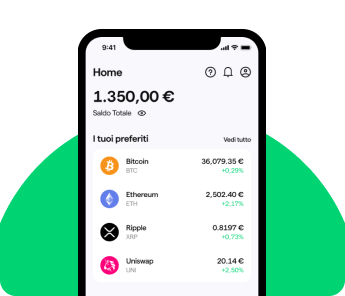News
Everything about Aptos, the new Layer 1 blockchain for lightning transactions
Filippo Iachello
7 min

Aptos is a brand new Layer 1 blockchain. What is it and how does it work?
This October, Aptos was launched. It is a new Layer 1 blockchain developed by former Meta employees. Only a few days after its debut in the crypto world, Aptos has already been making waves, both in a positive and negative sense. On the one hand, there are those who present Aptos and its APT crypto as the possible Solana Killer, due to the large amount of transactions per second it promises to be able to process. On the other hand, Aptos’s launch has been criticised due to several factors, such as the ‘premature’ listing on well-known crypto exchanges prior to the release of APT’s tokenomics. Find out what the Aptos project is, and what the main controversies surrounding the launch are!
The birth of of a brand new crypto: Aptos
Aptos is a Layer 1 blockchain founded by a group of former employees of Meta (formerly Facebook). The group of developers founded the Aptos Foundation in August 2022, which is responsible for defining the guidelines of the project. The new blockchain uses a Proof-of-Stake consensus algorithm to validate transactions on its network. The new Aptos crypto is programmed in Move, a smart contract writing language developed by Facebook in 2019. Move was created to build Facebook’s native blockchain, Diem. However, the project was abandoned in January 2022.
Even before its launch, Aptos’s Layer 1 blockchain and its APT crypto have been the talk of the town. How come? A great amount of interest in the project was shown from major venture capital funds, who also decided to invest in the project. Aptos raised 350 million through three different funding rounds between March and September 2022. The funds came from some of the most important venture capitalists in the crypto market such as Andreessen Horowitz (a16z), Jump Crypto, FTX Ventures and Binance Labs.
How does Aptos work? The new Layer 1 blockchain
The new Aptos Layer 1 blockchain underwent an intensive testing programme during the months leading up to its launch. Using a Proof-of-Stake consensus algorithm, Aptos works thanks to 102 validators who are responsible for the security of the network. The project wants to distinguish itself by its ability to process more than 160,000 transactions per second, a number far greater than that of other Layer 1 blockchains. To date, the competitor to beat is Solana. On paper, this Layer 1 blockchain can process the largest number of transactions per second, reaching a maximum of 65,000. For this reason, Aptos was called a possible Solana Killer at its launch.
The Aptos Foundation wants to ensure a high amount of usability of the network for its users. One of the main weaknesses that Web3 is facing is complexity of use. Thanks in particular to the Move programming language, Aptos wants to improve this! Move has been designed to build more user-friendly smart contracts and DApps, which can also be used by those who are not familiar with the technologies involved.
In this first week since its launch, the Aptos network became very active. Especially so with regard to NFTs, which have recorded considerable volumes. For instance, the Aptos Monkeys collection, which was launched on the NFT marketplace Topaz, raised nearly 300,000 APTs (around $2.7 million) in the first 24 hours after its launch. The main wallet for storing and using APT tokens and NFTs on Aptos is a web extension called Petra, which has already exceeded 300,000 downloads on the chrome web store.
Aptos: an opaque beginning?
The launch of Aptos has undoubtedly broken the monotony of this bear market, generating much controversy but also some appreciation. Let’s proceed in order. The first criticism arose in the hours before the launch. Users who had participated in the Aptos testnet (an almost identical copy of the main blockchain being used for experimentation), received a very substantial airdrop. The rewards distributed via the airdrop were either 150 or 300 units of the new Aptos cryptocurrency, depending on the tasks the users performed on the testnet. The Aptos Foundation distributed 20.1 million crypto APTs, representing approximately 2% of the total supply. This amount of APT was, at the time of distribution, worth between 200 and 260 million dollars. It was divided among 110,235 crypto wallets.
The criticism in this case was that the airdrop was excessive and benefited the so-called ‘airdrop hunters’. They are users who complete tasks required by blockchain protocols using different wallets. Once they receive the airdrop, they instantly sell the crypto they have received.
The second wave of criticism concerns the choice of Aptos and some exchanges including Binance and FTX to make trading available before the tokenomics were officially released. This choice by the Aptos Foundation put potential investors in an uncomfortable position. On the one hand, they would not have wanted to miss the launch of Aptos, but on the other hand, they felt insecure given the lack of transparency shown by the project.
The tokenomics of APT, the crypto of Aptos
The tokenomics publication, which came only after listing on some of the best-known exchanges, provides for a total APT supply of one billion tokens. 510 million are held by venture capital companies, and 410 million are held by the Aptos Foundation. These 410 million tokens are locked as of today, and will be unlocked progressively over the next 10 years. The remaining part of Aptos’ supply, a total of 80 million APTs, have partly been distributed through airdrops and partly will be made available to projects that will be created on the blockchain.
If the delay in the publication of tokenomics generated controversy, the structure of tokenomics itself only increased it. The price of APT has suffered as a result. The main factor that created discontent is the amount of APT owned by venture capital companies and the Aptos Foundation. According to users, there are too many tokens held by institutional investors and the Aptos Foundation. This could generate strong sell pressure on the APT token in the future.
The influence on the price could be seen immediately after the launch. The starting price of the Aptos crypto was around $14. In the first hours after the launch, it marked a downward movement of more than 40%. In the days following the launch, the price of APT ‘stabilised’ at around $9.
PancakeSwap is the first DeFi DApp to land on Aptos
On Monday the 24th October 2022, PancakeSwap, the decentralised exchange (DEX) built on the Binance Smart Chain, announced that its platform will also be available on Aptos. The decision was made following a vote within PancakeSwap’s DAO. PancakeSwap’s ecosystem on Aptos will be similar to the one already present on the Binance Smart Chain.
Thus, Swaps will be enabled. These are a mechanism through which tokens built on the Aptos blockchain can be exchanged. Farms and Pools, where you can stack your tokens in exchange for rewards, will also be made available as well as the IFO section. The acronym stands for Initial Farm Offering, and it is a kind of ‘Initial Coin Offering’ (ICO). IFOs have the dual purpose of allowing to raise development funds for emerging projects, and incentivising users to hold crypto in the ecosystem. To participate in an IFO, it is necessary to lock your tokens in an LP (liquidity pool), which consists of 50% CAKE crypto and 50% APT.
The integration of PancakeSwap, which is the eighth DeFi ecosystem in terms of TVL, is certainly a good achievement. We will see if the new Aptos Layer 1 blockchain will continue to integrate new features at this pace, and if it will one day be able to compete with Solana in the challenge for creating the most scalable network.




